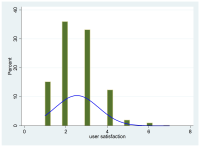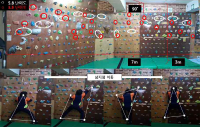PURPOSE This study aimed to identify the decision-making process for consumers participating in sports centers based on an extended goal-directed behavior model (EMGB), and to provide empirical data for establishing effective operation strategies for sports centers, including additional risk perception of consumers during pandemic. METHODS A total of 446 surveys were used as the final sample. For data analysis, SPSS 21.0 and AMOS 21.0 were used for frequency analysis, correlation analysis, confirmatory factor analysis, and structural equation model analysis. RESULTS Except for hypothesis 2 and 9, all of the hypothesis were chosen. CONCLUSIONS The findings suggested that extended goal-oriented behavior models can increase consumers' cognitive and emotional factors through emotional aspirations, suggesting that a lower risk perception of COVID19 increases their desire to participate in sports centers, and provides academic fundamental data on how to increase and activate sports centers.
Purpose The purpose of this study is to investigate the factors for setting proper training duration of frequency that can guarantee the student athletes' right to study and performance, and to derive the ranks of setting proper training duration of frequency of student athletes by school level. Consequently, to provide basic data for the development of training guidelines for the growth period of Korean student athletes. Methods Delphi and Analytic Hierarchical Process(AHP) techniques were used. The Delphi survey was conducted in three phases, and collected data through Delphi survey were computed by SPSS win ver. 22.0 and Excel, using the mean, standard deviation, median, and coefficient of variation. Using the AHP technique, we classified the factors for setting proper training duration of frequency derived through Delphi survey, and calculated the importance by using Microsoft Excel 2010. Conclusion First, elementary students should be guaranteed regular class participation, have basic after school training, and be provided with adequate rest so that they do not lose interest in the exercise. Second, middle school students are required to decide whether to continue exercise based on their ability to exercise and abundant experience. Therefore, when abandoning the exercise, students should be able to faithfully carry out their academic performance. Third, high school students are directly related to college entrance and employment, so they have to concentrate on performance rather than on academic performance.
PURPOSE This study aimed to verify the differences in anticipated regret and gambling discontinuance intent based on the fear appeal type and source similarity in different types of horse-racing gamblers. METHODS Using convenience sampling, 172 responses were collected from horse-racing participants who bought horseracing tickets within the last 6 months. After eliminating 30 insincere responses, descriptive, correlation, reliability, and two-way multivariate covariance analyses were conducted using SPSS Ver. 26.0. RESULTS Anticipated regret and discontinuance intent were higher under fear appeal using social compared with financial risk. Compared to recreational gamblers, problem gamblers had higher anticipated regret and discontinuance intent under fear appeal using social compared with financial risk. There were no differential impacts of source similarity on anticipated regret and discontinuance intent in both types of gambler. CONCLUSIONS Practitioners in charge of conducting messaging campaign to prevent addiction to horse-racing gambling may cause problem gamblers to expect regret and quit gambling by delivering preventive messages with relatively unfamiliar risks such as social risks, rather than familiar risks such as financial ones.
Purpose The purpose of this study was to investigate the relationship between physical activity and depression according to the presence of disease. Methods A survey and basic assessment were conducted for 2,754 (Male=1,025 and Female=1,729) aged 40 and over who participated in the rural-based cohort study. The survey included physical activity, depression scale and disease preservation. The basic assessment measured height, weight, and body fat percentage. The measured data were analyzed by using logistic regression to examine the relationship between physical activity and depression prevalence. Results First, physical activity reduced the prevalence of depression by 33% and 51%, respectively, in the general population and in patients with the disease. Second, physical activity once or twice per week reduced the prevalence of depression in patients with disease by 51%, and at least three physical activities reduced the prevalence of depression by 37% in the general population and 33% of patients with disease. Third, physical activity less than 150 minutes per week reduced the prevalence of depression in patients with disease by 43%, and physical activity of more than 150 minutes and less than 300 minutes per week reduced the prevalence of 43% of the general population and 52% of patients with disease. Physical activity over 300 minutes per week had a 38% reduction in the prevalence of depression in the general population. Conclusions This study suggests that the level of physical activity suggested by the ACSM guidelines is appropriate to reduce the prevalence of depression. In addition, the patients with the disease was found to be effective with less frequency and amount of physical activity than the general person.

Purpose The study aims to analyze the factors affecting the Residents user satisfaction in order to improve the management of the Open School Sports Center the support facility of the National Sports Promotion Fund. Methods This data is based on Korea Institute of Sports Science(KISS)'s Open School Sports Center Usage Status and Satisfaction Survey (2016) and Open School Sports Center use performance. The analysis model is a regression model (TOBIT) that takes into account the limited characteristics of dependent variables. Results The results are as follows: the satisfaction is negatively related age, number of regulations, weekday opening hours, and usage fees. Conclusion Therefore, in order to increase the satisfaction of Open School Sports Center residents users, various supports are needed. This includes funds for PR, discounts and user-friendliness. It also requires differentiated management of each Center. In the case of regions and facilities, consumer-oriented policies need to be applied instead of collective standards.


Purpose The purpose of this study was to investigate the effects of coupled high frequency rTMS and prism illusion in elderly stroke patients, based on the result of previous studies which discovered the effect of bilateral training, mirror rehabilitation treatment, and rTMS. Methods This is a case study of 4 stroke patients who were homogeneous on the basis of selection criteria such as brain injury area, duration of onset, degree of upper limb movement function. A total of 24 rehabilitation sessions were conducted three times a week during the training period, and TMS(transcranial magnetic stimulator), EMG, motion analysis system, and prism optical glasses were used for apparatus. Results The results of the study were as follows: Combined rehabilitation exercises were found to be beneficial to restore upper limb function in stroke patients. Particularly, the maximum speed of stretching and JTT(Jebsen-taylor Test) performance showed improvement after training. The amount of total map volume and MEP(megnetic evoked potential) increased in evaluation of neurophysiology. Conclusion The upper limb dysfunction of stroke patients could be restored by combine rehabilitation exercises.








PURPOSE The purpose of this study was to investigate the relationship between the integrated marketing communication (IMC) attribute of professional baseball teams, their fans’ perceived value, and voluntary behavior related to the parent company. METHODS In this study, the target population consisted of spectators watching a professional baseball game. A survey was conducted on 360 fans watching the KIA tigers’ and kt wiz’ home game using the convenience sampling method. Finally, a total of 261 were used for data analysis, and frequency, confirmatory factor, reliability, correlation, structural equation model analyses using SPSS 20.0 and AMOS 20.0. RESULTS Main findings are as follows: First, interactivity of professional baseball teams’ IMC had positive effects on the emotional value. Second, interactivity and reminders from the parent companies of professional baseball teams’ IMC had positive effects on social value. Third, stakeholder connectivity and reminders from parent company of professional baseball teams’ IMC had positive effects on altruistic value. Fourth, with regard to the social aspect, the fans’ perceived value had positive effects on loyalty, customer participation and customer cooperation of voluntary behavior related to parent company. Lastly, with regard to the altruistic aspect, the fans’ perceived value had positive effects on customer cooperation of voluntary behavior related to the parent company. CONCLUSIONS Therefore, professional baseball teams should identify the IMC elements that fans perceive as important and establish effective marketing communication strategies to enhance the perceived value of their brand among their fans, ultimately increasing their voluntary engagement with the parent company.

[Purpose] The study was designed to examine the effects of a 10-week sports climbing training on body composition and surrogate indices of major lifestyle disease in obese elderly women. [Methods] Twenty elderly women, whose percent body fat was over 35%, were randomly assigned into one of two groups, i.e., sports climbing training group (TR: n=10) and control group (CON: n=10). The subjects in TR completed sports climbing training program with 5.8 and 5.9 of difficulty, at 11-13 of ratings of perceived exertion (RPE), 60 min/session, three sessions/wk for 10 weeks. Independent variables regarding body composition and major lifestyle disease, i.e., hypertension, dyslipidemia, and atherosclerosis, were measured and compared between two groups as well as between two tests simultaneously using a repeated two-way ANOVA. [Results] Regarding physique and body composition, there were significant interactions between group and test in body weight, body mass index, fat mass, and percent body fat. These variables decreased significantly in TR. 2) Regarding indices of hypertension, systolic blood pressure, diastolic blood pressure, mean arterial pressure, and pulse pressure decreased significantly in TR. Regarding indices of dyslipidemia, triglyceride decreased significantly in TR. Regarding indices of atherosclerosis, TG/HDL-C ratio decreased significantly in TR. [Conclusions] It was concluded that the 10-week sports climbing training would be beneficial for reduction of body fat despite its’ influence on fat-free mass was limited, and would also contribute on improving surrogate indices of hypertension, dyslipidemia, and atherosclerosis in obese elderly women. Future research investigating the effects of various period, intensity, duration, and frequency of sports climbing training would be warranted.
